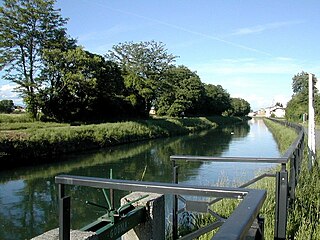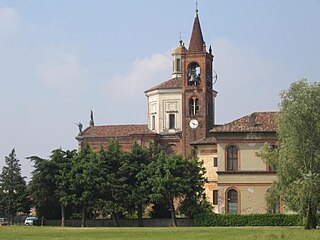
The Province of Milan was a province in the Lombardy region, Italy. Its capital was the city of Milan. The area of the former province is highly urbanized, with more than 2,000 inhabitants/km2, the third highest population density among Italian provinces, just below the densities of the provinces of Naples and of Monza e Brianza, the latter of which was created in 2004 from the north-eastern part of the province of Milan. On January 1, 2015 the province was replaced by the Metropolitan City of Milan.

Rodano is a city and comune in the Metropolitan City of Milan, Lombardy, northern Italy.

The Naviglio della Martesana is a canal in the Lombardy region, Northern Italy. Running from the Adda river, in the vicinity of Trezzo sull'Adda, to Milan, it was also known as Naviglio Piccolo. It is part of the system of navigli of the Milan area.

Brianza is a geographical, historical and cultural area of Italy, at the foot of the Alps, in the North-West of Lombardy, between Milan and Lake Como.

Bernate Ticino is a comune (municipality) in the Metropolitan City of Milan in the northern Italian region Lombardy, located about 25 kilometres (16 mi) west of Milan.

Corbetta is a comune (municipality) in the Metropolitan City of Milan in the Italian region Lombardy.

The Olona is an Italian river belonging to the Po Basin, 71 kilometres (44 mi) long, that runs through the Province of Varese and Metropolitan City of Milan whose course is developed entirely in Lombardy.
Turro is a district ("quartiere") of Milan, Italy, part of the Zone 2 administrative division, located north-east of the city centre. Before being annexed to Milan in 1918, it was an autonomous comune. The name derives from tur, the Lombard word for "tower". The Milan Metro subway has a stop at Turro.
Lambrate is a district (quartiere) of Milan, Italy, located within the Zone 3 administrative division, six km (3.7 mi) north-east of the city centre. It owes its name to the Lambro river that traverses the area. Lambrate houses one of the major railway stations of north-eastern Milan, the Stazione di Milano Lambrate. The district is also well known for Parco Lambro, a large urban park established in 1934. The famous Lambretta motor scooter was manufactured in Lambrate, and named after this district, as is Birrificio Lambrate, a craft brewery established in 1996.

Ponte Lambro is a district ("quartiere") of Milan, Italy. It is the outermost part of the Zone 4 administrative division, extending south-east of the city centre.
Vaiano Valle is a rural district ("quartiere") of Milan, Italy, part of the Zone 5 administrative division. It is located south of the city's urban area, within the Parco Agricolo Sud Milano nature reserve. Before 1869, it was an autonomous comune.

Chiaravalle is a district (quartiere) of Milan, Italy, part of the Zone 5 administrative division of the city. It is located in the periphery south of the city centre, within the Parco Agricolo Sud Milano nature reserve.
Quintosole is a district ("quartiere") of Milan, Italy, part of the Zone 5 administrative division. It is a rural district, located within the Parco Agricolo Sud Milano nature reserve, south of Milan's urban area. Before 1869, it was an autonomous comune.

Barona is a border district ("quartiere") of the city of Milan, Italy. It is part of the Zone 6 administrative division, and it is located south of the city centre. Its population can be roughly estimated to 85,000. It borders on the comunes of Buccinasco, Assago, and Corsico and the districts of Lorenteggio and Torretta. Its boundaries are marked by the Parco Agricolo Sud Milano nature reserve to the south, by the Naviglio Grande and Naviglio Pavese canals to the east and to the west, and by the Circonvallazione ring road to the north.
FEDENATUR is an association of natural, fluvial and agricultural parks located in metropolitan and periurban areas in Europe. It is headquartered in the Serra de Collserola Natural Park in Barcelona.

The Pavese is a geographical and historical area in the Pianura Padana of northern Italy, located in south-western Lombardy. It constitutes one of the 3 territories in which is divided the Province of Pavia.

The Increa Park is a green area in communal ownership in the south-west part of Brugherio, in Lombardy. Inside the Italian park is a large lake and the remains of the Increa Quarry, which gives its name to the park. This park is part of a larger national park called Parco Est delle Cave. It borders Cernusco sul Naviglio and it is near Milan's eastern bypass road. It covers about 33 hectares.

The following outline is provided as an overview of and topical guide to Milan:

The hydrography of Milan and the area of the neighboring municipalities is particularly complex, both for natural causes, given the conspicuous presence of rivers, streams and fountains that form a real water tangle, and for issues related to the work of canalization and diversion of waterways made by man, having their beginning during the Roman era, which led to the creation of numerous irrigation ditches, canals and lakes.















